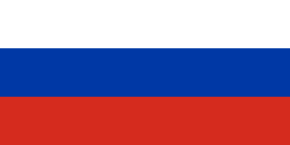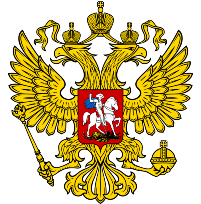Russia: Difference between revisions
No edit summary |
No edit summary |
||
| Line 57: | Line 57: | ||
[[File:Flag of Russia (1858–1883).svg|none|thumb|Russian Empire (1858-1883)|319x319px]] | [[File:Flag of Russia (1858–1883).svg|none|thumb|Russian Empire (1858-1883)|319x319px]] | ||
[[File:Flag of Russia (1896–1918).svg|none|thumb|Flag of Russia (1896-1918)[[File:Flag of the Russian Soviet Federative Socialist Republic (1918–1925).svg|none|thumb|Russian flag 1918]]]] | [[File:Flag of Russia (1896–1918).svg|none|thumb|Flag of Russia (1896-1918)[[File:Flag of the Russian Soviet Federative Socialist Republic (1918–1925).svg|none|thumb|Russian flag 1918]]]] | ||
[[File:Flag of Russia.svg|none|thumb|Current Russian Flag]] | |||
Revision as of 16:36, 1 March 2024
| ||||||||||||||||||||||||||||||||||||||||||||||||||||||||

Russia (Russian: Россия, romanized: Rossiya), or the Russian Federation, is a country spanning Eastern Europe and Northern Asia. It is the largest country in the world by area, extending across eleven time zones. It shares land boundaries with fourteen countries. It is the world's ninth-most populous country and Europe's most populous country. The country's capital as well as its largest city is Moscow. Saint Petersburg is Russia's second-largest city and cultural capital. Other major urban areas in the country include Novosibirsk, Yekaterinburg, Nizhny Novgorod, Chelyabinsk, Krasnoyarsk, Kazan, Krasnodar and Rostov-on-Don.
The East Slavs emerged as a recognised group in Europe between the 3rd and 8th centuries CE. The first East Slavic state, Kievan Rus', arose in the 9th century, and in 988, it adopted Orthodox Christianity from the Byzantine Empire. Rus' ultimately disintegrated, with the Grand Duchy of Moscow growing to become the Tsardom of Russia. By the early 18th century, Russia had vastly expanded through conquest, annexation, and the efforts of Russian explorers, developing into the Russian Empire, which remains the third-largest empire in history. However, with the Russian Revolution in 1917, Russia's monarchic rule was abolished and eventually replaced by the Russian SFSR—the world's first constitutionally socialist state. Following the Russian Civil War, the Russian SFSR established the Soviet Union with three other Soviet republics, within which it was the largest and principal constituent. At the expense of millions of lives, the Soviet Union underwent rapid industrialisation in the 1930s and later played a decisive role for the Allies in World War II by leading large-scale efforts on the Eastern Front. With the onset of the Cold War, it competed with the United States for global ideological influence. The Soviet era of the 20th century saw some of the most significant Russian technological achievements, including the first human-made satellite and the first human expedition into outer space.
In 1991, the Russian SFSR emerged from the dissolution of the Soviet Union as the independent Russian Federation. A new constitution was adopted, which established a federal semi-presidential system. Since the turn of the century, Russia's political system has been dominated by Vladimir Putin, under whom the country has experienced democratic backsliding and a shift towards authoritarianism. Russia has been militarily involved in a number of conflicts in former Soviet states and other countries, including its war with Georgia in 2008 and annexation of Crimea in 2014 from neighbouring Ukraine, followed by the further annexation of four other regions in 2022 during an ongoing invasion.
Internationally, Russia ranks among the lowest in measurements of democracy, human rights and freedom of the press; the country also has high levels of perceived corruption. The Russian economy ranks 11th by nominal GDP, relying heavily on its abundant natural resources, and 68th by GDP per capita. Its mineral and energy sources are the world's largest, and its figures for oil production and natural gas production rank highly globally. Russia possesses the largest stockpile of nuclear weapons and has the third-highest military expenditure. The country is a permanent member of the United Nations Security Council; a member state of the G20, SCO, BRICS, APEC, OSCE, and WTO; and the leading member state of post-Soviet organisations such as CIS, CSTO, and EAEU/EEU. Russia is home to 30 UNESCO World Heritage Sites.
World War Two
The country's roots lay in the October Revolution of 1917, which saw the Bolsheviks overthrow the Russian Provisional Government that formed earlier that year following the February Revolution that had dissolved the Russian Empire. The new government, led by Vladimir Lenin, established the Russian Soviet Federative Socialist Republic (RSFSR), the world's first constitutionally socialist state. Persisting internal tensions escalated into the brutal Russian Civil War. As the war progressed in the Bolsheviks' favor, the RSFSR began to incorporate land acquired from the war into nominally independent states, which were merged into the Soviet Union in December 1922. Following Lenin's death in 1924, Joseph Stalin came to power. Stalin inaugurated a period of rapid industrialization and forced collectivization that led to significant economic growth, but also contributed to a famine in 1930–1933 that killed millions. The forced labour camp system of the Gulag was also expanded in this period. During the late 1930s, Stalin conducted the Great Purge to remove his actual and perceived opponents. In 1939 the USSR and Nazi Germany signed the Molotov–Ribbentrop Pact which sought to bring peaceful relations to the respective countries, despite their ideological incongruence. Nonetheless, in 1941, Nazi Germany invaded the Soviet Union in the largest land invasion in history, opening the Eastern Front of World War II. The Soviet civilian and military casualties of the war — estimated at around 27 million people — accounted for the majority of Allied losses. In the aftermath of World War II, the Soviet Union consolidated the territory occupied by the Red Army, forming various Soviet satellite states and undertook rapid economic development which cemented its status as a superpower.
Russian Armed Forces
The russian armed forces current chief is Toxic_Formadi, for the ground forces. The russian airforce current chief is Sjavbax, Colonel General and Head of the Aviation Regiment. The russian navy is currently closed due to lack of admirals and sailors, by the rest the Russian Federation has a very powerful naval fleet.
The capital City
Moscow, is the current capital of the Russian Federation and is the richest city ever. Russia is planning on expanding and enlarging it's territory. The russian army program's on the country's expansion is long but there's still hope.
Flags History





